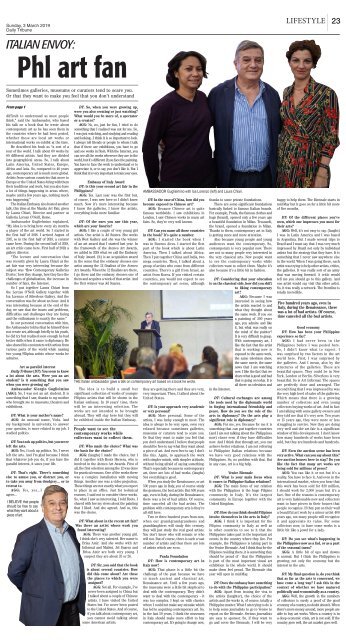03 MARCH 2019
Create successful ePaper yourself
Turn your PDF publications into a flip-book with our unique Google optimized e-Paper software.
Sunday, 3 March <strong>2019</strong><br />
Daily Tribune<br />
ITALIAN ENVOY:<br />
Phl art fan<br />
LIFESTYLE<br />
23<br />
Sometimes galleries, museums or curators tend to scare you.<br />
Or that they want to make you feel that you don’t understand<br />
From page 1<br />
difficult to understand as most people<br />
think,” said the Ambassador, who based<br />
his talk on a book that he wrote about<br />
contemporary art as he has seen them in<br />
the countries where he had been posted,<br />
whether these are local art works or<br />
international works on exhibit at the time.<br />
He described his book as “a sort of a<br />
tour of the world. I talk about 60 works by<br />
60 different artists. And they are divided<br />
into geographical areas. So, I talk about<br />
Latin America, United States, Europe,<br />
Africa and Asia. So, compared to 40 years<br />
ago, contemporary art is much more global.<br />
Artists from various countries that move to<br />
Europe or the United States bring with them<br />
their traditions and work, but you also have<br />
a lot of things happening in areas where,<br />
maybe until a few years ago, nothing much<br />
was happening.”<br />
The Italian Embassy also hosted another<br />
talk, this time at the Manila Art Fair, given<br />
by Laura Chiari, Director and partner at<br />
Galleria Lorcan O’Neill, Rome.<br />
Ambassador Guglielmino explained,<br />
“My idea is to bring here every six months<br />
a player of the art world. So I started in<br />
the first half of 2018. I arrived August of<br />
2017, so in the first half of 2018, a curator<br />
came here. During the second half of 2018,<br />
an art critic came here. First half of <strong>2019</strong>, a<br />
gallery director.<br />
“The lecture and conversation that<br />
was recently given by Laura Chiari at the<br />
art fair was very interesting because the<br />
subject was ‘How Contemporary Galleries<br />
Evolve,’ how they change, how they face the<br />
challenges of globalization, the increase in<br />
number of fairs, the Internet.<br />
So I put together Laura Chiari from<br />
the Lorcan O’Neill Gallery together with<br />
Isa Lorenzo of Silverlens Gallery. And the<br />
conversation was for about an hour. And it<br />
was interesting because at the end of the<br />
day, we saw that the issues and problems,<br />
difficulties and challenges they are facing<br />
and the enthusiasm is exactly the same.”<br />
In our personal conversation with him,<br />
the Ambassador told us that he himself does<br />
not create art, although briefly in his youth,<br />
he did try but realized soon enough he had<br />
better skills when it came to diplomacy. He<br />
also shared his encounters with artists from<br />
various parts of the world while naming<br />
two young Filipina artists whose works he<br />
admires.<br />
Art as parallel interest<br />
Daily Tribune (DT): You seem to know<br />
a lot about the arts. Were you an art<br />
student? Is it something that you saw<br />
when you were growing up?<br />
Ambassador Giorgio Guglielmino<br />
(AGG): No, I was not an art student. It is<br />
something that I saw, thanks to my mother<br />
who brought me to museums, theaters and<br />
exhibitions.<br />
DT: What is your mother’s name?<br />
AGG: An unusual name, Viola. And<br />
my background in university, to answer<br />
your question, is more related to my job. I<br />
studied politics.<br />
DT: You took up politics, but you never<br />
left the arts.<br />
AGG: Yes, I took up politics. No, I never<br />
left the arts. And I’m glad because I think<br />
that whatever job you do, if you have the<br />
parallel interest, it saves your life.<br />
DT: That’s right. There’s something<br />
else to amuse you, or distract you, or<br />
to take you away from drudgery… or to<br />
retreat to.<br />
AGG: Yes, yes…I<br />
agree…<br />
I BELIEVE that people<br />
should be free to say<br />
what they want about a<br />
piece of art.<br />
DT: So, when you were growing up,<br />
were you also creating or just watching?<br />
What would you be more of, a spectator<br />
or a creator?<br />
AGG: No, no, just for fun, I tried to do<br />
something that I realized was not for me. So,<br />
I was just watching, and studying and reading<br />
and looking…I think it is so important to look.<br />
I always tell friends or people to whom I talk<br />
that if there are exhibitions, you have to go<br />
and see works in flesh. With the Internet, you<br />
can see all the works wherever they are in the<br />
world, but it’s different if you face the painting.<br />
You have to face the work to understand or to<br />
appreciate it, or to say you don’t like it. But I<br />
think that it is very important to train your eyes.<br />
Embassy of Italy Award<br />
DT: Is this your second art fair in the<br />
Philippines?<br />
AGG: Yes. Last year was the first but,<br />
of course, I was new here so I didn’t know<br />
much. Now it’s more interesting because<br />
I know the galleries, I know the artists,<br />
everything looks more familiar.<br />
DT: Of the ones you saw this year,<br />
which are your favorite?<br />
AGG: I like a couple of very young girl<br />
artists. One artist is Jel Suarez. She works<br />
with West Gallery and she was the winner<br />
of an art award that I started last year. In<br />
the framework of the Ateneo Art Awards,<br />
we added in 2018 what we call the Embassy<br />
of Italy Award. (It) is an acquisition award<br />
in the sense that the embassy chooses one<br />
artist among the 12 finalists of the Ateneo<br />
Art Awards. When the 12 finalists are there,<br />
I go there and the embassy chooses one of<br />
them and acquires a work of that artist. And<br />
the first winner was Jel Suarez.<br />
The idea is to build a small but<br />
significant collection of works of younger<br />
Filipino artists that will be shown in the<br />
Italian embassy. In 10 years’ time, there<br />
will be an interesting selection. The<br />
works are not intended to be brought<br />
abroad. They will stay here but they will<br />
be exhibited inside the Italian Embassy.<br />
People want to see the<br />
contemporary works while<br />
collectors want to collect them.<br />
DT: Who made the choice? What was<br />
the basis for the choice?<br />
AGG: (laughs) I made the choice, but I<br />
did it together with Boots Herrera, who is<br />
involved in the Ateneo Art Awards. First of<br />
all, the first selection among the 12 was done<br />
for practical reasons. One of the works there<br />
was a complex installation with moving<br />
things. Another one was a video projection.<br />
These things are not exactly what you expect<br />
to place in an office. Just for technical<br />
reasons, I said not to consider these works.<br />
So, what I saw as interesting, I told Boots. I<br />
shared with her my views about the painting<br />
that I liked. And she agreed. And so, this<br />
was the choice.<br />
DT: What about in the recent art fair?<br />
Was there an artist whose work you<br />
found interesting?<br />
AGG: There was another young girl.<br />
I think she’s very talented. Her name is<br />
Brisa Amir. And she works with Art<br />
Informal and Mabini. Jel Suarez and<br />
Brisa Amir are both very young. I<br />
suspect they are about 25 or 26.<br />
DT: Sir, you said that the book<br />
is about several countries. How<br />
did this come about? Are these<br />
the places to which you were<br />
assigned?<br />
AGG: Not all. For example, I’ve<br />
never been assigned to China but<br />
I talked about a couple of Chinese<br />
artists. I have visited the United<br />
States but I’ve never been posted<br />
to the United States. And of course,<br />
if you talk about contemporary art,<br />
you cannot avoid talking about<br />
some American artists.<br />
AMBASSADOR Guglielmino with Isa Lorenzo (left) and Laura Chiari.<br />
DT: In the case of China, how did you<br />
become exposed to Chinese art?<br />
AGG: Because Chinese art is quite<br />
famous worldwide. I saw exhibitions in<br />
London, I saw Chinese works in many art<br />
fairs. So, they’re very well known.<br />
DT: Can you name all those countries<br />
in the book? It’s quite a number.<br />
AGG: I started the book when I<br />
was in Buenos Aires. I started the first<br />
part of the book which is about Latin<br />
America. Then I talked about Africa.<br />
Then I put together China and India, two<br />
mega countries. Then, I talked about a<br />
group of artists who come from different<br />
countries. There’s a girl from Israel, an<br />
artist from Korea. If you visited certain<br />
countries, you would not expect to see<br />
the contemporary art scene, although<br />
THE Italian ambassador gave a talk on contemporary art based on a book he wrote.<br />
they are getting there and they are very,<br />
very important. Then, I talked about the<br />
United States.<br />
DT: Is your approach very academic<br />
or very personal?<br />
AGG: More personal. Some of the<br />
artists, I was lucky enough to meet. The<br />
idea is always to be very open, even very<br />
relaxed because sometimes galleries,<br />
museums or curators tend to scare you.<br />
Or that they want to make you feel that<br />
you don’t understand. I believe that people<br />
should be free to say what they want about<br />
a piece of art. And even free to say I don’t<br />
like this. Again, to approach the work<br />
with simpler minds, with simpler attitude,<br />
without being afraid of saying something.<br />
That’s especially because in contemporary<br />
art, there are lots of bad works. (laughs)<br />
Not everything is good.<br />
When you study the Renaissance, or art<br />
500 years ago in Italy, you of course study<br />
the geniuses, the best artists. But 500 years<br />
ago, even in Italy, during the Renaissance,<br />
there was a lot of bad artists. Of course,<br />
time canceled all the bad artists. The<br />
problem with contemporary arts is they’re<br />
all still here.<br />
Two or three hundred years from now,<br />
when our grand-grand-grandsons and<br />
granddaughters will study this century,<br />
they will just study the real good artists.<br />
You don’t know who will remain or who<br />
will not. But of course, there is such a vast<br />
number of artists and then there are lots<br />
of artists which are so-so.<br />
Prada Foundation<br />
DT: How is contemporary art in<br />
Italy now?<br />
AGG: That phase is a little bit the<br />
challenge of the past because we have<br />
so much ancient and classical art,<br />
Renaissance art. Until a few years ago,<br />
the museums were a little bit skeptical to<br />
deal with the contemporary. They didn’t<br />
want to deal with the contemporary -- it<br />
was too complex. I kept on with classics<br />
where I could not make any mistake which<br />
has led to acquiring contemporary art. So,<br />
in the last 50 years, I think the museums<br />
in Italy should make more effort to buy<br />
contemporary art. It’s going to change now,<br />
thanks to some private foundations.<br />
There are some significant foundations<br />
basically linked to famous Italian brands.<br />
For example, Prada, the famous clothes and<br />
bags (brand), opened only a few years ago<br />
a beautiful foundation in Milan. Trussardi,<br />
the brand, opened a foundation in Milan.<br />
Thanks to them, contemporary art in Italy<br />
is getting more and more attention.<br />
Also because young people and young<br />
audiences want the contemporary. So,<br />
contemporary is very popular now. There<br />
are not so many people very interested in<br />
the very classical arts. Now people want<br />
to see the contemporary works while<br />
collectors want to collect them. Maybe it’s<br />
also because it’s a little bit in fashion.<br />
DT: Considering that your education<br />
is on the classical side, how did you shift<br />
to liking contemporary<br />
art?<br />
AGG: Because I was<br />
interested in seeing how<br />
the artists reacted to and<br />
what they thought about<br />
the same work. If you see<br />
a painting of 300 years<br />
ago, you admire and like<br />
it, but what was really on<br />
the mind of the painter?<br />
It is very difficult to grasp.<br />
With contemporary art, I<br />
like the fact that the artist<br />
that is working now is<br />
exposed to the same work,<br />
the same television show,<br />
the same movie, the same<br />
news that I am watching<br />
now. I like the fact that we<br />
share what is good and bad<br />
that is going on today. It is<br />
all there on television and<br />
in the Internet.<br />
DT: Cultural exchanges are among<br />
the tools used by the diplomatic world<br />
in forging international friendship and<br />
peace. How do you see the role of the<br />
arts in diplomacy? Do the arts play a<br />
significant role in diplomacy?<br />
AGG: For me, yes. Because for me it is<br />
something that can put together countries<br />
(and I am not talking about the Philippines<br />
now) closer even if they have difficulties<br />
now. And I think that through art, you can<br />
achieve better relations. I am not referring<br />
to Philippine Italian relations because<br />
we have very good relations with the<br />
Philippines. So, no problem with that. But<br />
in any case, art is a big help.<br />
Venice Biennale<br />
DT: What is your main focus when<br />
it comes to Philippine-Italian relations?<br />
AGG: The main focus of our relation<br />
with the Philippines is the huge Filipino<br />
community in Italy. It’s the largest<br />
community in Europe together with the<br />
United Kingdom.<br />
DT: How do you think should Filipinos<br />
involve themselves in the arts in Italy?<br />
AGG: I think it is important for the<br />
Filipino community in Italy as well as<br />
in other countries to see to it that the<br />
Philippines takes part in the important art<br />
events in the country where they live. For<br />
example, the Philippines is taking part in<br />
the Venice Biennale. And I think that for the<br />
Filipinos residing there, it is something they<br />
should be proud of - that the Philippines<br />
is part of the most important visual art<br />
exhibition in the whole world. It should<br />
make them feel proud. The Biennale this<br />
year will open in mid-May.<br />
DT: Does the embassy have something<br />
to do with the Philippine participation?<br />
AGG: Apart from issuing the visa to<br />
the artists (laughter), the choice of the<br />
artists and the works is, of course, totally a<br />
Philippine matter. What I am trying to do is<br />
to help some journalists to go to Venice to<br />
report on the Biennale. Serious journalists<br />
are easy to sponsor. So, if they want to<br />
go and cover the Biennale, I will be very<br />
happy to help them. The Biennale starts in<br />
mid-May but it goes on for a little bit more<br />
of five months.<br />
DT: Of the different places you’ve<br />
seen, which one impresses you most for<br />
their arts?<br />
AGG: Well, it’s not easy to say. (laughs)<br />
I was in Latin America and I was based<br />
in Argentina. But I made several trips to<br />
Brazil and I must say that I was very much<br />
impressed by Brazil not only by individual<br />
artists but the strategy that they have. It is<br />
something that I never saw anywhere else<br />
in the world. When I was going there, each<br />
artist was trying to help other artists, critics,<br />
the galleries. It was really sort of an army<br />
that was moving forward. A critic would<br />
tell me you should go to this gallery. And<br />
one artist would say visit this other artist.<br />
So, it was really a network. The frontline is<br />
totally incredible.<br />
Five hundred years ago, even in<br />
Italy, during the Renaissance, there<br />
was a lot of bad artists. Of course,<br />
time canceled all the bad artists.<br />
Good economy<br />
DT: How has been your Philippine<br />
experience so far?<br />
AGG: I had never been in the<br />
Philippines before I was posted here.<br />
So, I didn’t know what to expect. I<br />
was surprised by two factors in the art<br />
world here. First, I was surprised by<br />
the galleries. And I mean, also by the<br />
structures of the galleries. These are<br />
beautiful spaces. They could be in New<br />
York, London or Berlin. Silverlens is very<br />
beautiful. So is Art Informal. The spaces<br />
are perfectly done and arranged. The<br />
second thing that I was impressed by was<br />
the very high level of sales of the galleries.<br />
Which means that there is a growing<br />
number of collectors and even young<br />
collectors buying works of art. And in fact<br />
I am talking with some gallery owners and<br />
they told me that it’s very new. Ten years<br />
or 15 years ago, they were more or less<br />
struggling to survive. Now they are doing<br />
very well and the art fair is a significant<br />
window of this development. I don’t know<br />
how many hundreds of works have been<br />
sold, but they are hundreds and hundreds.<br />
DT: Even the auction scene has been<br />
very active. What can you say about this?<br />
Are auction houses here to stay? Do you<br />
like the fact that many art works are<br />
being sold for millions of pesos?<br />
AGG: You can like it or not but it’s a<br />
reality. You have to face it. And even in the<br />
international market, when you hear that<br />
this work has been sold for $20 million,<br />
I should work for 2,000 years but it’s a<br />
fact. One of the reasons is contemporary<br />
art is very fashionable now and collectors<br />
want to have pieces in their houses that<br />
people recognize. If they put on their wall<br />
a beautiful art work by a minor artist 400<br />
years ago, not many people will recognize<br />
it and appreciate its value. For some<br />
collectors now, to have some works is a<br />
little bit like a jewel for a lady.<br />
DT: Do you see what’s happening in<br />
the Philippines now as a fad, or as a part<br />
of the seasonal turns?<br />
AGG: A little bit of ups and downs<br />
is normal. But I think the Philippines is<br />
growing; not only the economy but the<br />
interest in the arts.<br />
DT: My final question is, do you think<br />
that as far as the arts is concerned, we<br />
have come a long way? I ask this in the<br />
context of whether we have matured<br />
politically and economically as a country.<br />
AGG: Well, the growth in the numbers<br />
of collectors is surely a proof of the good<br />
economy of a country, no doubt about it. When<br />
there’s more money around, more people are<br />
able to buy art works. When a country is in<br />
a deep economic crisis, art is not sold. If the<br />
country goes well, the art market goes well.


















